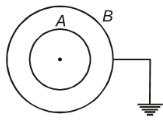The electric potential at a point at distance √3R from the centre of disc
of radius R lying in the axis of the disc whose surface charge density is σ
will be given by:
1. σ2ε0[2-√3]R 2. σ2ε0[2+√3]R
3.σ2ε0[√3-√2]R 4. σ2ε0[√3+√2]R
of radius R lying in the axis of the disc whose surface charge density is σ
will be given by:
1. σ2ε0[2-√3]R 2. σ2ε0[2+√3]R
3.σ2ε0[√3-√2]R 4. σ2ε0[√3+√2]R
An elementary particle of mass m and charge e is projected with velocity v at a much more massive particle of charge Ze, where . What is the closest possible approach of the incident particle ?
1.
2.
3.
4.
A and B are two concentric metallic shells. If A is positively charged and B is earthed, then electric


1. Field at common centre is non-zero
2. Field outside B is nonzero
3. Potential outside B is positive
4. Potential at common centre is positive
An air capacitor of capacity C=10μF is connected to a constant voltage battery of 12 V. Now the space between the plates is filled with a liquid of dielectric constant 5. The charge that flows now from battery to the capacitor is
1. 120 μC
2. 699 μC
3. 480 μC
4. 24 μC
The figure shows some of the equipotential surfaces. Magnitude and direction of the electric field is given by

1. 200 V/m, making an angle 1200 with the x-axis
2. 100 V/m, pointing towards the negative x-axis
3. 200 V/m, making an angle -600 with the x-axis
4. 100 V/m, making an angle 300 with the x-axis
In the circuit shown in the figure, the energy stored in 6 μF capacitor will be:

| 1. | 48×10−6 J | 2. | 32×10−6 J |
| 3. | 96×10−6 J | 4. | 24×10−6 J |
Four equal charges Q are placed at the four corners of a square of each side is ‘a’. Work done in removing a charge – Q from its centre to infinity is
(1) 0
(2) √2Q24πε0a
(3) √2Q2πε0a
(4) Q22πε0a
Two spheres of radius a and b respectively are charged and joined by a wire. The ratio of the electric field at the surface of the spheres is
(1) a/b
(2) b/a
(3) a2/b2
(4) b2/a2
An electron of mass m and charge e is accelerated from rest through a potential difference V in vacuum. The final speed of the electron will be
(1) V√e/m
(2) √eV/m
(3) √2eV/m
(4) 2eV/m
The dimension of (1/2) ε0E2 (ε0: permittivity of free space; E: electric field) is
(1) MLT–1
(2) ML2L–2
(3) ML–1T–2
(4) ML2T–1






